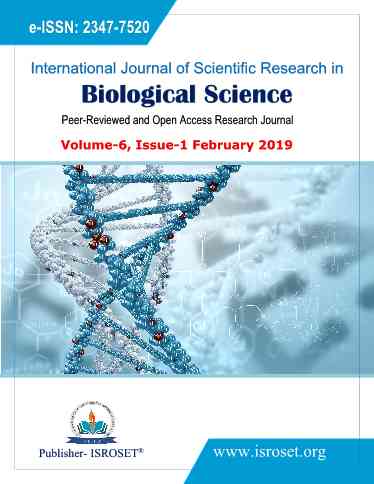Relationship between Number of Teats and Litter Size in Eutherian Mammals
Keywords:
Teats, Litter Size, Mammary glands, Eutherian mammals, Teat formulaAbstract
Mammals are vertebrates with hair and mammary glands, which produce milk for nursing their young. Mammals may be divided into two groups Prototheria and Theria. Prototherian are oviparous and Therian are viviparous. Theria is a subclass of mammals. It includes Eutherians (placental mammals) and metatherians (marsupial mammals). Mammals have a wide variety of skin glands, but all seem to be variations of two major glands, Sudoriferous (sweat) and Sebaceous (oil) glands. Mammary glands appear to be modified sebaceous glands. A teat is the projection from the breast or dug or udder or mammary glands of mammals. A litter is the live birth of multiple offspring at one time in animals from the same mother and usually from one set of parents. In this research we test the hypothesis of Gilbert’s ``one-half rule``. According to one half-rule, the average number of young in a litter is one half the typical numbers of teats and the maximum litter size is equal to the total number of teats. To find relationship between number of teats and litter size, various examples of mammalian species are considered and a comparison and correlation was drawn. In this research we also introduced teat formula (Tf) in mammals for the first time.
References
G.C. Kent. “Comparative anatomy of the vertebrates”, CV Mosby Company Japan, pp. 465, 1978.
R. Pearl. “On the correlation between the number of mammae of the dam and size of litter in mammals: Interracial correlation”, Proceedings of the Society for experimental Biology and Medicine, Vol.10, pp. 27-30, 1913.
A.N. Gilbert. “Mammary number and litter size in Rodentia: the “one-half rule””, Proc. Natl Acad Sci, USA, Vol.83, pp. 4828-4830, 1986.
A.E. Eisenberg. “Reproduction in polyprotodont marsupials and similar sized eutherians with a speculation concerning the evolution of litter size in mammals”, Yale University Press, New Haven, pp. 291-310, 1988.
K. Kratochwil. “In vitro analysis of the hormonal basis for the sexual dimorphism in the embryonic development of the mouse mammary gland”, Journal of Embryology and Experimental morphology, Vol.25, pp. 141-158, 1971.
K. Kratochwil and P. Schwartz. “Tissue interaction in androgen response of the embryonic mammary rudiment of mouse: Identification of target tissue for testosterone”, Proceedings of the National Academy of Sciences, USA, Vol.73, pp. 4041-4044, 1976.
P Stockley and L Hobson. “Parental care and litter size co-evolution in mammals”, Proc. R. Soc. B. pp. 283, 2016.
L. Partridge. “Lifetime reproductive success and life history evolution”, Academic press London, United Kingdom, pp. 479, 1989.
C.G. Hartman. Possums, University of Texas Press, Austin, pp. 174, 1952.
E.R. Guiler. “Observations on the Tasmanian devil, Sarcophilus harrisii (Marsupialia: Dasyuridae): Reproduction breeding and growth of pouch young”, Australian Journal of Zoology, Vol.18, pp. 63-70, 1970.
R.L. Hughes. “Reproduction in the Tasmanian devil, Sarcophilus harrisii (Dasyuridae, Marsupialia)”, Royal Zoological Society of New South Wales, Sydney, Australia, pp. 1396, 1982.
J. Tuomi. “Mammalian reproductive strategies: a generalized relation of litter size to body size”, Oecologia, Vol.45, pp. 39-44, 1980.
L.E. Jeppensen. “Teat order in groups of piglets reared on an artificial sow. Formation of teat order and influence of milk yield on teat preferences”, Appl Anim Behav, Vol.8, pp. 335-345, 1982.
I. Mansergh and D. Scotts. “Aspects of the life history and breeding biology of the mountain pygmy possum, Burromys parvus (Marsupialia- Burramyidae) in alpine Victoria (Australia)”, Aust Mamal Vol.13, pp. 178-192, 1990.
M.M.A. Mahmoud, Z. Szendro and E.B. Nemeth. “Correlation between teat number of does and baby rabbits”. All Es Takar, Vol.39, pp. 321-325, 1990.
P.W. Sherman, S. Braude and J.U.M. Jarvis. “Litter size and mammary numbers of naked mole rats: Breaking the one-half rule”, Journal of Mammalogy, Vol.80, I. 3, pp. 720-733, 1999.
Downloads
Published
How to Cite
Issue
Section
License

This work is licensed under a Creative Commons Attribution 4.0 International License.
Authors contributing to this journal agree to publish their articles under the Creative Commons Attribution 4.0 International License, allowing third parties to share their work (copy, distribute, transmit) and to adapt it, under the condition that the authors are given credit and that in the event of reuse or distribution, the terms of this license are made clear.







